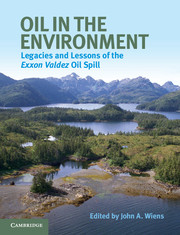Book contents
- Frontmatter
- Contents
- List of contributors
- Use of acronyms
- Acknowledgments
- A bibliographic note
- Prologue
- Part I Introduction and background
- Part II Oil in the environment
- Part III Biological effects
- 9 Cytochrome P450 1A (CYP1A) as a biomarker in oil spill assessments
- 10 Assessing effects and recovery from environmental accidents
- 11 Shoreline biota
- 12 Oiling effects on pink salmon
- 13 Pacific herring
- 14 Oil and marine birds in a variable environment
- 15 Sea otters: trying to see the forest for the trees since the Exxon Valdez
- Part IV Assessing oil spill effects and ecological recovery
- Part V Conclusions
- Index
- References
14 - Oil and marine birds in a variable environment
Published online by Cambridge University Press: 05 July 2013
- Frontmatter
- Contents
- List of contributors
- Use of acronyms
- Acknowledgments
- A bibliographic note
- Prologue
- Part I Introduction and background
- Part II Oil in the environment
- Part III Biological effects
- 9 Cytochrome P450 1A (CYP1A) as a biomarker in oil spill assessments
- 10 Assessing effects and recovery from environmental accidents
- 11 Shoreline biota
- 12 Oiling effects on pink salmon
- 13 Pacific herring
- 14 Oil and marine birds in a variable environment
- 15 Sea otters: trying to see the forest for the trees since the Exxon Valdez
- Part IV Assessing oil spill effects and ecological recovery
- Part V Conclusions
- Index
- References
Summary
Introduction
Marine birds are among the most conspicuous elements of coastal ecosystems. Their variety, abundance, visibility, and behavior resonate with the public. They are also particularly vulnerable to oil spills. Most marine-bird species forage at or beneath the water’s surface, where they are at risk of exposure to floating oil. Additionally, many feed and nest along shorelines where floating oil can accumulate, and some form large breeding colonies that are susceptible to oil spills. Over 200 000 marine birds died as a direct consequence of the Exxon Valdez oil spill, and images of oiled birds dominated media coverage. Federal regulations requiring documentation of injuries to natural resources from oil spills (see Chapter 1) prompted multiple studies of marine birds, fueling debates about short- and long-term effects of the spill and subsequent recovery.
Determining how an oil spill (or any large environmental disturbance) affects marine birds is complicated by variation in the environment and in how birds respond to that environment. Coastal environments vary substantially from place to place and time to time. At high-latitude locations such as Prince William Sound (PWS), diurnal and monthly changes in tides; seasonal variations in storms, water temperatures, and productivity; and multiyear changes in ocean temperature and circulation such as El Niño events and the Pacific Decadal Oscillation can have dramatic effects. At any time, marine birds may be responding to a host of environmental factors over a range of scales, from the availability of suitable nesting sites along a small stretch of shoreline to the abundance of prey over a broad region or to variation in hemispheric-scale forces affecting the ocean. Because these influences do not disappear when an oil spill occurs, they and any associated environmental variations must be accounted for when assessing spill effects. Population changes attributed to an oil spill must be rigorously tested and documented, not just inferred.
- Type
- Chapter
- Information
- Oil in the EnvironmentLegacies and Lessons of the Exxon Valdez Oil Spill, pp. 318 - 347Publisher: Cambridge University PressPrint publication year: 2013
References
- 2
- Cited by



